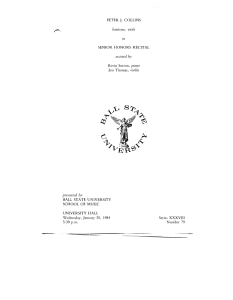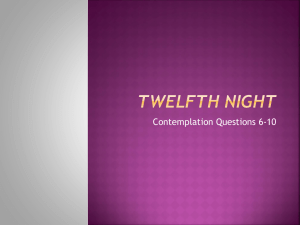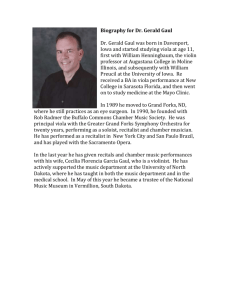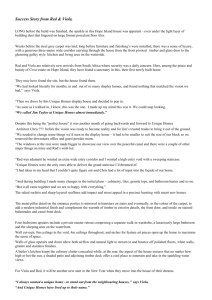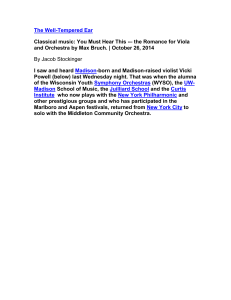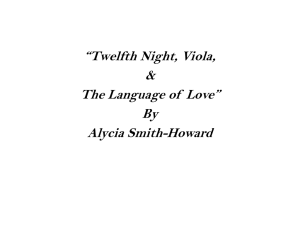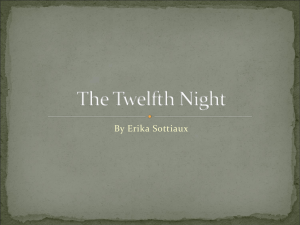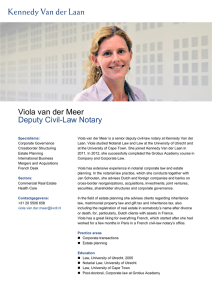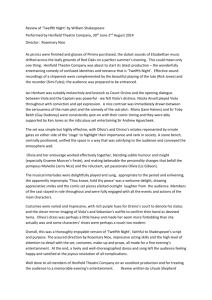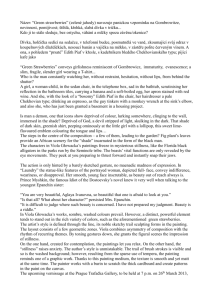Prestidigitation, Computer Music Journal: Spring 2011
advertisement
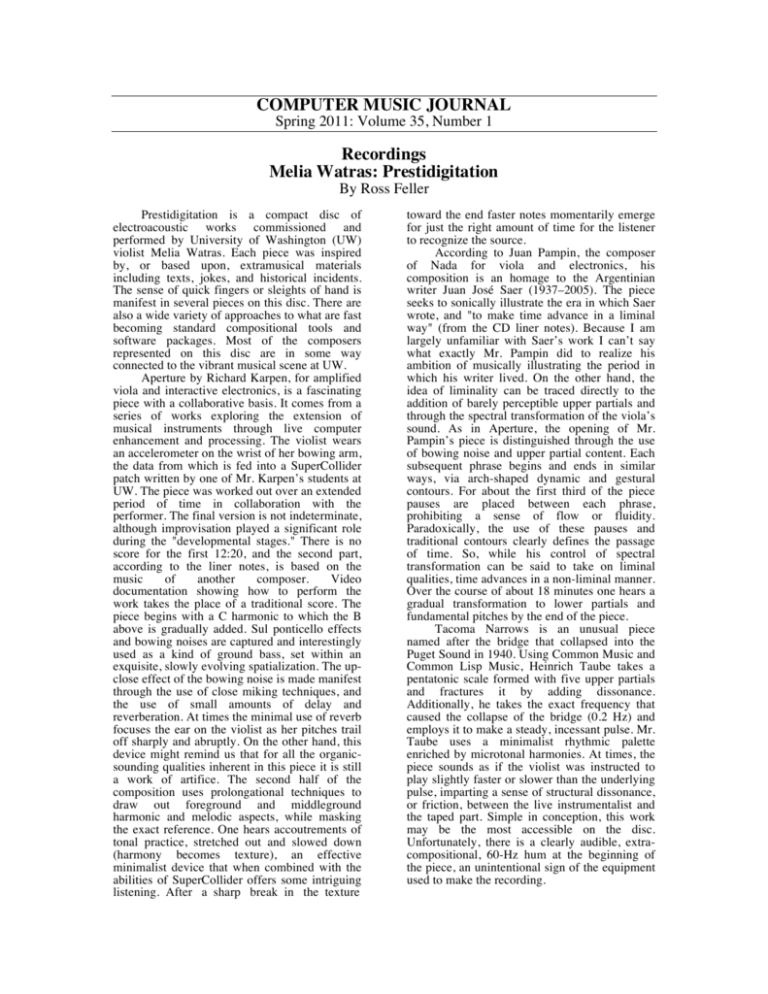
COMPUTER MUSIC JOURNAL Spring 2011: Volume 35, Number 1 Recordings Melia Watras: Prestidigitation By Ross Feller Prestidigitation is a compact disc of electroacoustic works commissioned and performed by University of Washington (UW) violist Melia Watras. Each piece was inspired by, or based upon, extramusical materials including texts, jokes, and historical incidents. The sense of quick fingers or sleights of hand is manifest in several pieces on this disc. There are also a wide variety of approaches to what are fast becoming standard compositional tools and software packages. Most of the composers represented on this disc are in some way connected to the vibrant musical scene at UW. Aperture by Richard Karpen, for amplified viola and interactive electronics, is a fascinating piece with a collaborative basis. It comes from a series of works exploring the extension of musical instruments through live computer enhancement and processing. The violist wears an accelerometer on the wrist of her bowing arm, the data from which is fed into a SuperCollider patch written by one of Mr. Karpen’s students at UW. The piece was worked out over an extended period of time in collaboration with the performer. The final version is not indeterminate, although improvisation played a significant role during the "developmental stages." There is no score for the first 12:20, and the second part, according to the liner notes, is based on the music of another composer. Video documentation showing how to perform the work takes the place of a traditional score. The piece begins with a C harmonic to which the B above is gradually added. Sul ponticello effects and bowing noises are captured and interestingly used as a kind of ground bass, set within an exquisite, slowly evolving spatialization. The upclose effect of the bowing noise is made manifest through the use of close miking techniques, and the use of small amounts of delay and reverberation. At times the minimal use of reverb focuses the ear on the violist as her pitches trail off sharply and abruptly. On the other hand, this device might remind us that for all the organicsounding qualities inherent in this piece it is still a work of artifice. The second half of the composition uses prolongational techniques to draw out foreground and middleground harmonic and melodic aspects, while masking the exact reference. One hears accoutrements of tonal practice, stretched out and slowed down (harmony becomes texture), an effective minimalist device that when combined with the abilities of SuperCollider offers some intriguing listening. After a sharp break in the texture toward the end faster notes momentarily emerge for just the right amount of time for the listener to recognize the source. According to Juan Pampin, the composer of Nada for viola and electronics, his composition is an homage to the Argentinian writer Juan José Saer (1937–2005). The piece seeks to sonically illustrate the era in which Saer wrote, and "to make time advance in a liminal way" (from the CD liner notes). Because I am largely unfamiliar with Saer’s work I can’t say what exactly Mr. Pampin did to realize his ambition of musically illustrating the period in which his writer lived. On the other hand, the idea of liminality can be traced directly to the addition of barely perceptible upper partials and through the spectral transformation of the viola’s sound. As in Aperture, the opening of Mr. Pampin’s piece is distinguished through the use of bowing noise and upper partial content. Each subsequent phrase begins and ends in similar ways, via arch-shaped dynamic and gestural contours. For about the first third of the piece pauses are placed between each phrase, prohibiting a sense of flow or fluidity. Paradoxically, the use of these pauses and traditional contours clearly defines the passage of time. So, while his control of spectral transformation can be said to take on liminal qualities, time advances in a non-liminal manner. Over the course of about 18 minutes one hears a gradual transformation to lower partials and fundamental pitches by the end of the piece. Tacoma Narrows is an unusual piece named after the bridge that collapsed into the Puget Sound in 1940. Using Common Music and Common Lisp Music, Heinrich Taube takes a pentatonic scale formed with five upper partials and fractures it by adding dissonance. Additionally, he takes the exact frequency that caused the collapse of the bridge (0.2 Hz) and employs it to make a steady, incessant pulse. Mr. Taube uses a minimalist rhythmic palette enriched by microtonal harmonies. At times, the piece sounds as if the violist was instructed to play slightly faster or slower than the underlying pulse, imparting a sense of structural dissonance, or friction, between the live instrumentalist and the taped part. Simple in conception, this work may be the most accessible on the disc. Unfortunately, there is a clearly audible, extracompositional, 60-Hz hum at the beginning of the piece, an unintentional sign of the equipment used to make the recording. University of Washington Professor Emerita Diane Thome contributes a highly dramatic and melancholic piece entitled And Yet... for viola and computer-realized sound. The piece is self-referential in several ways. All of the electroacoustic sounds were taken from an earlier piece by the composer for solo violin. Samples from this piece were then used and transformed in the new work. It is also composed with reference to another earlier work for viola and electronics. According to the composer, the title, taken from the 18th-century Japanese poet Issa, suggests an elegiac quality. To create the computer part Ms. Thome used Metasynth Pro and Soundhack. The combination of lyricism and timbral modification for which Metasynth and Soundhack are best known is especially poignant in this piece, the most romantically lyrical on the disc. This effect was made even more apparent by the performer’s dramatic intakes of air heard before each phrase. The final piece of this collection is Viola Jokes by Brent Michael David. The liner notes for this work promise humor. It is scored for viola and tenor voice. The tenor’s straight-laced, operatic approach lends the piece a surreal, almost schizophrenic quality. The text “speaks” humor while it is sung in a serious, no-nonsense manner. This contradiction is what makes the composer succeed in his promise of humor. For the most part the viola is used effectively to punctuate and text-paint. Instances of the latter device often serve a humorous function. The compelling collective work on this disc unequivocally demonstrates that the University of Washington remains one of the vital centers for computer music in the USA today. 2
